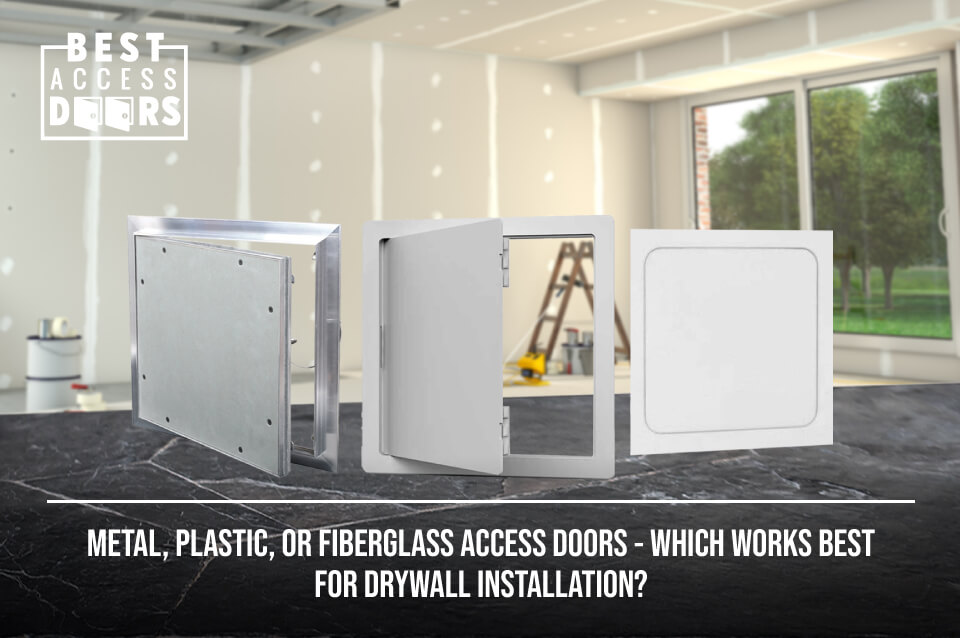Metal, Plastic, or Fiberglass Access Doors - Which Works Best for Drywall Installation?
Posted by Best Access Doors on 19th Apr 2023
Regarding drywall installation, access panels are an essential component that must address. These panels provide access to electrical wiring, plumbing, and other features that may require maintenance or repair. However, choosing the right type of access panel can be a challenge for drywall installers. This article will compare metal, plastic, and fiberglass access doors to determine which works best for drywall installation.
Metal Access Doors
Due to their durability and strength, metal access doors are a popular choice among drywall installers. They are typically made from steel or aluminum and can be powder-coated or painted to match the surrounding drywall. Metal access doors are fire-resistant and perfect for installations where fire safety is a concern. Additionally, metal access doors are known for their security features and can be locked to prevent unauthorized access.
Plastic Access Doors
Plastic access doors are a lightweight and affordable option for drywall installation. They are made of high-impact ABS plastic and come in different sizes and colors to fit your needs and match the drywall around them. Plastic access doors are easy to install and can remove without causing damage to the surrounding drywall. They can also stand up to moisture and corrosion, which makes them an excellent choice for installations in damp places.
Fiberglass Access Doors
Fiberglass access doors are a newer option for drywall installation but are gaining popularity due to their lightweight and durable nature. They are usually fiberglass that has to reinforce and come in different sizes and colors. Fiberglass access doors are an excellent option for outdoor installations because they won't rust, break down from the water, or fade from UV light. Also, they are easy to set up and can paint to match the surrounding drywall.
As a drywall installer, you may have experienced the frustration of installing access doors that do not fit properly or do not match the surrounding drywall. It can be time-consuming and costly, especially if the access door needs to be replaced or repaired. Choosing the right access door for each installation can avoid these issues and provide a high-quality building that meets your customers' needs.
Benefits of Installing Access Doors
There are several benefits to installing access doors in drywall installations. Firstly, access doors provide a convenient way to access essential components such as electrical wiring, plumbing, and HVAC systems. In the long run, there will be less need for repairs and maintenance. Additionally, access doors can improve the overall aesthetic of a building by providing a seamless and professional finish to the drywall.
Choosing the Right Size and Style
When selecting an access door, it is essential to think about the size and style opening. Access doors come in various sizes and styles to fit different types of drywall installations. For example, if you are installing an access door in a ceiling, you may need a larger size than installing it in a wall. Additionally, some access doors come with built-in insulation, which may be necessary for installations in areas with extreme temperatures.
Here are the advantages of installing Access Doors
- Easy access: Access doors provide a quick and convenient way to access pipes, wiring, and other components behind the drywall. It can save time and money by avoiding cutting a hole in the drywall whenever access is needed.
- Security: Access doors can provide a secure separation between the inside of the building from the access point, protecting against unauthorized access and potential theft or damage.
- Safety: Access doors can help to protect against fire hazards by providing access to fire suppression systems, fire alarms, and other safety equipment behind the drywall.
- Aesthetics: Access doors can design to blend seamlessly with the surrounding drywall, creating a clean and professional look that does not detract from the overall aesthetics of the building.
- Customization: Access doors can be customized to fit the specific needs of each installation, such as size, insulation, and locking mechanisms.
By installing drywall access panels, you can provide your customers with a safe, secure, and convenient solution that meets the specific needs of their building. Additionally, by highlighting the advantages of access doors, you can help to educate your customers and differentiate your services from competitors who may not offer access door installations.
How to Install Access Doors
Installing an access door may seem complicated, but having the right tools and methods can be easy.
Before we go to the installation guide, here are the tools needed to perform the installation:
- Measuring tape - to measure the dimensions of the access door and mark them on the drywall.
- Pencil or marker - to outline the access door on the drywall.
- Drywall saw or jigsaw - to cut along the design of the access door.
- Screwdriver - attach the access door to the drywall using the screws provided.
- Level - Ensure the access door is level and flush with the surrounding drywall.
- Joint compound or spackle - to create a seamless finish around the edges of the access door.
Depending on the installation, you may also need other tools, such as a drill, drywall anchors, or a utility knife. It's a great idea to look at the manufacturer's instructions for the specific tools and materials needed for your access door installation.
How to install:
Step 1 - Measure and Mark the Opening
- Ensure the opening is the correct size and shape for the access door.
- Measure the dimensions of the access door and mark them on the drywall using a pencil or marker.
- Use a level to ensure that the lines are straight and even.
Step 2 - Cut the Opening
- Cut along the outline using a drywall saw or jigsaw.
- Wear protective gear such as goggles and a dust mask to prevent inhaling dust and dirt.
- Take care not to damage any electrical or plumbing components in the process.
Step 3 - Install the Access Door
- Attach the access door to the drywall using the screws provided.
- Ensure that the screws are flush with the surface of the access door to prevent them from catching on anything.
- Check that the access door is level and flush with the surrounding drywall.
- Apply joint compound or spackle around the edges of the access door to create a seamless finish.
By following these installation tips, you can ensure a professional and secure installation of your access door that meets your customers' needs.
Conclusion
In conclusion, selecting the right access door for each drywall installation is essential for ensuring the building's safety, security, and convenience. Whether you choose a metal, plastic, or fiberglass access door, consider the specific needs of each installation, such as size, style, and insulation.
By addressing customer pain points and focusing on the benefits of installing a high-quality access door, you can provide a professional installation that meets your customers' needs. And with the proper installation techniques, you can ensure a seamless and secure finish to your drywall installation.
Order From Us Today!
Best Access Doors is worth considering if you're in the market for high-quality access doors and panels. We are committed to offering our customers the best products and resources to help them with their building and remodeling projects. Check out our blog for more information and tips on access panels and other building and remodeling topics. Just dial (888)-699-0949. You may request a customized quote; we will provide it in 30 minutes!
Don't let drywall access panels installation be a mystery. Download our free Ebook and become an expert today!
Share our story - get our 2024 Catalog for FREE!


